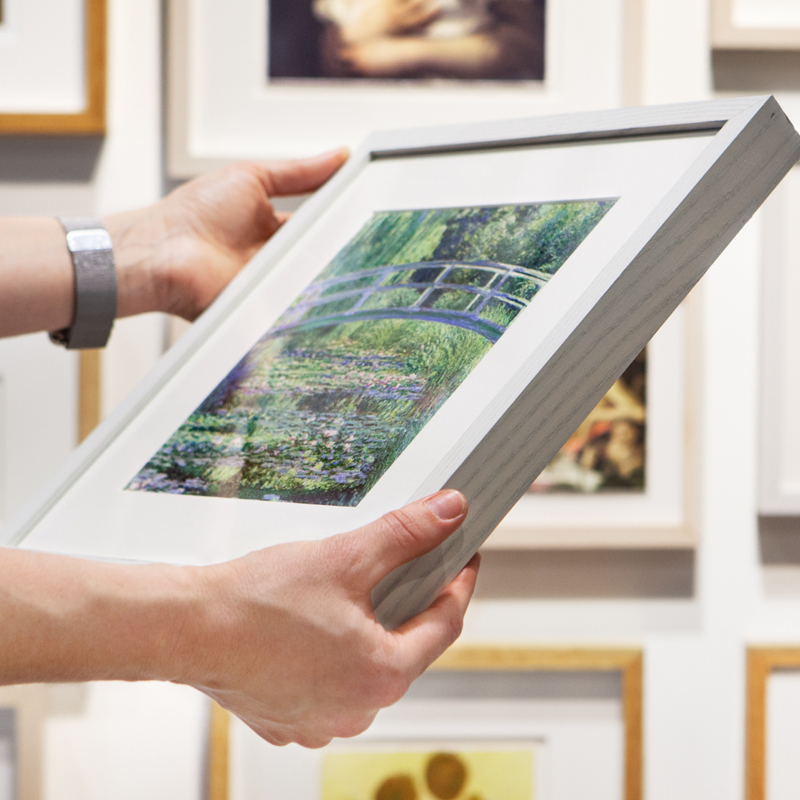Hilaire-Germain-Edgar Degas, 'Combing the Hair ('La Coiffure')', about 1896
About the work
Overview
Women combing their hair, or having it combed, often appear in Degas’s work, and this painting is one of his boldest treatments of the subject. A maid, wearing her servant’s uniform, combs the hair of her seated mistress, who is not yet fully dressed. Pulled back by the force of the strokes, the mistress raises her right hand to her head as if to steady herself or hold her hair in place.
The composition is sketched in with bold sweeps of the brush, and Degas mainly limits the colours to variations of a fiery orange-red painted over a creamy white ground, which is still visible on the left of the canvas. Some areas are more defined than others – the objects on the table, for example, look unfinished. Degas probably planned to work further on the painting, but it was never completed and remained in his studio. After his death, it was bought by Henri Matisse.
Audio description
Listen to an audio description of Hilaire-Germain-Edgar Degas's 'Combing the Hair' ('La Coiffure')
Transcript
This is a description of 'Combing the Hair', also known in French as 'La Coiffure', by Edgar Degas. It’s oil on canvas painted about 1896. Just over one metre high and almost one and a half metres wide, it is in a gilded frame.
This striking picture stands out for its intense use of the colour red, as if seen through a fiery red filter. A woman sits on a low chair, facing to the left. Her long red hair is being combed by a woman standing behind her, on the right. Behind them is an orange-red wall and scarlet curtain.
The space feels shallow, almost claustrophobic. In the foreground to the right, the corner of a white table top juts into the composition. On it are objects relating to a dressing table, but only loosely sketched in. A brush and hand mirror provide a focus point of marigold orange.
The women are behind the table. From their clothes, the relationship between them can be understood as the seated mistress on the left, attended by her uniformed maid on the right. She wears a white apron, partially hidden by the table. Standing upright, her head reaches the top of the painting, her auburn hair pulled up into a high bun on top of her head. She wears a pink blouse with full, mutton-leg sleeves billowing out from her shoulders. Facing left, her downward gaze is on her hands. With her left she is lifting the long, heavy, length of her mistress’s red hair. Her right arm reaches over the top, pulling a comb through the midpoint of the hair.
The seated mistress leans back in her chair at 45 degrees, so her head is at the height of the maid’s waist. The mistress wears a loose, short sleeved dress, which creates a flat area of bright red. Her right arm is thrown up, as if in surprise or resistance, her hand pressing down on her hairline. This is presumably to relieve the tug she feels from the comb. Her other arm, nearest to us, is bent and tucked into her side. She may not be reclining through choice, but perhaps because of the vigour of the maid’s combing, which is pulling her head back.
The painting feels experimental and loosely finished. Black outlines are drawn freely and rapidly, with a broad dry brush, leaving the texture of the canvas exposed in places. The facial features of the women are sketchy, but the two figures form a dynamic diagonal across the composition from bottom left to top right. It follows the reclining figure of the mistress, her hair bridging the gap between her and the maid, who continues the line upward. The structure has a powerful tension, reinforced by the intense use of red paint and the possible tension between mistress and maid.
Behind the women, on the red wall, some lighter paint is dabbed to suggest what might be a picture frame. This is partly obscured by a heavy red curtain, which cuts across the top left corner of the composition, the lower part of the fabric created by a couple of cursory black brushstrokes. This is the most daringly sparce area of the picture.
The painting remained in Degas’s studio until the end of his life, so we don’t know if he intended to continue working on it.
It is perhaps unsurprising that one of the picture’s past owners was the painter Henri Matisse, an artist who was also known for his ground-breaking experiments in colour and line.
Key facts
Details
- Full title
- Combing the Hair ('La Coiffure')
- Artist
- Hilaire-Germain-Edgar Degas
- Artist dates
- 1834 - 1917
- Date made
- about 1896
- Medium and support
- oil on canvas
- Dimensions
- 114.3 × 146.7 cm
- Acquisition credit
- Bought (Knapping Fund), 1937
- Inventory number
- NG4865
- Location
- Room 45
- Collection
- Main Collection
- Frame
- 19th-century French Frame
Provenance
Additional information
Text extracted from the ‘Provenance’ section of the catalogue entry in Martin Davies, with additions and some revisions by Cecil Gould, ‘National Gallery Catalogues: French School: Early 19th Century, Impressionists, Post-Impressionists, etc.’, London 1970 and supplemented by Isobel Muir; for further information, see the full catalogue entry.
Exhibition history
-
2010Picasso Looks at DegasSterling and Francine Clark Art Institute13 June 2010 - 12 September 2010Museu Picasso14 October 2010 - 16 January 2011
-
2014Making ColourThe National Gallery (London)18 June 2014 - 7 September 2014
-
2016Painters' Paintings: From Freud to Van DyckThe National Gallery (London)23 June 2016 - 4 September 2016
-
2016Degas: A New VisionThe Museum of Fine Arts (Houston)16 October 2016 - 16 January 2017
-
2017Drawn in Colour: Degas from the BurrellThe National Gallery (London)20 September 2017 - 7 May 2018
-
2023After Impressionism: Inventing Modern ArtThe National Gallery (London)25 March 2023 - 13 August 2023
Bibliography
-
1922R. Hoppe, Degas och hans arbeten i nordisk ägo, Stockholm 1922
-
1938National Gallery, National Gallery and Tate Gallery Directors' Reports, 1937, London 1938
-
1946Martin Davies, National Gallery Catalogues: French School, London 1946
-
1946P.-A. Lemoisne, Degas et son oeuvre, Paris 1946
-
1957Martin Davies, National Gallery Catalogues: French School, 2nd edn (revised), London 1957
-
1970Davies, Martin, and Cecil Gould, National Gallery Catalogues: French School: Early 19th Century, Impressionists, Post-Impressionists etc., London 1970
-
1974J. Adhémar and F. Cachin, Degas: The Complete Etchings, Lithographs and Monotypes, London 1974
-
1974J. Lassaigne and F. Minervino, Tout l'oeuvre peint de Degas, Paris 1974
-
1979D. Sutton, 'Edgar Degas: Master of the Melodic Line', Apollo, 1979, pp. 166-75
-
1980S. Willoch, 'Edgar Degas: Nasjonalgalleriet', Kunst og Kultur, 1980, pp. 22-4
-
1985R. Kendall, 'Degas's Colour', in R. Kendall (ed.), Degas 1834-1984, Manchester 1985, pp. 19-31
-
1986D. Sutton, Edgar Degas: Life and Work, New York 1986
-
1987L. Freud, The Artist's Eye: Lucian Freud (exh. cat. The National Gallery, 17 June - 16 August), London 1987
-
1988J.S. Boggs et al., Degas (exh. cat. Galeries Nationales du Grand Palais, 9 February - 16 May 1988; National Gallery of Canada, 6 June - 28 August 1988; Metropolitan Museum of Art, 27 September 1988 - 8 January 1989), New York 1988
-
1989D. Sutton, 'The Degas Sales and England', The Burlington Magazine, CXXXI/1033, 1989, pp. 266-72
-
1990F. Milner, Degas, London 1990
-
1996J.S. Boggs, Degas, Chicago 1996
-
1996R. Kendall, Degas: Beyond Impressionism (exh. cat. The National Gallery, 22 May - 26 August 1996; Art Institute of Chicago, 28 September 1996 - 5 January 1997), London 1996
-
1997A. Dumas et al., The Private Collection of Edgar Degas (exh. cat. Metropolitan Museum of Art, 1 October 1997 - 11 January 1998), New York 1997
-
2001
C. Baker and T. Henry, The National Gallery: Complete Illustrated Catalogue, London 2001
-
2004D. Bomford et al., Degas (exh. cat. The National Gallery, 10 November 2004 - 30 January 2005), London 2004
About this record
If you know more about this work or have spotted an error, please contact us. Please note that exhibition histories are listed from 2009 onwards. Bibliographies may not be complete; more comprehensive information is available in the National Gallery Library.

















